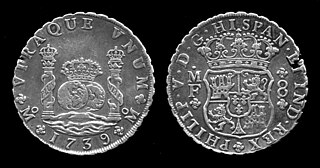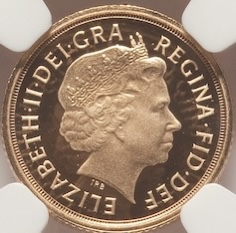
The Krugerrand is a South African coin, first minted on 3 July 1967 to help market South African gold and produced by Rand Refinery and the South African Mint. The name is a compound of Paul Kruger, the former President of the South African Republic, and rand, the South African unit of currency. On the reverse side of the Krugerrand is a pronking springbok, South Africa's national animal.

The standard circulating coinage of the United Kingdom, British Crown Dependencies and British Overseas Territories is denominated in pennies and pounds sterling, and ranges in value from one penny sterling to two pounds. Since decimalisation, on 15 February 1971, the pound has been divided into 100 pence. Before decimalisation, twelve pence made a shilling, and twenty shillings made a pound.

The kwacha is the currency of Malawi as of 1971, replacing the Malawian pound. It is divided into 100 tambala. The kwacha replaced other types of currency, namely the British pound sterling, the South African rand, and the Rhodesian dollar, that had previously circulated through the Malawian economy. The exchange rate of the kwacha undergoes fixed periodical adjustments, but since 1994 the exchange rate has floated. In 2005, administrative measures were put in place by Bingu wa Mutharika to peg the exchange rate with other currencies. Banknotes are issued by the Reserve Bank of Malawi. In May 2012, the Reserve Bank of Malawi devalued the kwacha by 34% and unpegged it from the United States dollar. The currency was further devalued by 25% by the central bank in May 2022 followed by another 44% devaluation in November 2023 raising inflation rate in Malawi.

A penny is a coin or a unit of currency in various countries. Borrowed from the Carolingian denarius, it is usually the smallest denomination within a currency system. At present, it is the formal name of the British penny (abbr. p) and the de facto name of the American one-cent coin (abbr. ¢) as well as the informal Irish designation of the 1 euro cent coin (abbr. c). Due to inflation, pennies have lost virtually all their purchasing power and are often viewed as an expensive burden to merchants, banks, government mints and the public in general.

Pound is the name of various units of currency. It is used in some countries today and previously was used in many others. The English word "pound" derives from the Latin expression lībra pondō, in which lībra is a noun meaning 'pound' and pondō is an adverb meaning 'by weight'. The currency's symbol is '£', a stylised form of the blackletter 'L', crossed to indicate abbreviation.

The crown was a denomination of sterling coinage worth a quarter of one pound. The crown was first issued during the reign of Edward VI, as part of the coinage of the Kingdom of England.

Sterling is the currency of the United Kingdom and nine of its associated territories. The pound is the main unit of sterling, and the word pound is also used to refer to the British currency generally, often qualified in international contexts as the British pound or the pound sterling.

The Royal Mint is the United Kingdom's official maker of British coins. It is currently located in Llantrisant, Wales, where it moved in 1968.

The mark was a currency or unit of account in many states. It is named for the mark unit of weight. The word mark comes from a merging of three Germanic words, Latinised in 9th-century post-classical Latin as marca, marcha, marha or marcus. It was a measure of weight mainly for gold and silver, commonly used throughout Europe and often equivalent to 8 troy ounces (250 g). Considerable variations, however, occurred throughout the Middle Ages.

The pound was the currency of Australia from 1910 until 14 February 1966, when it was replaced by the Australian dollar. Like other £sd currencies, it was subdivided into 20 shillings, each of 12 pence.
The fineness of a precious metal object represents the weight of fine metal therein, in proportion to the total weight which includes alloying base metals and any impurities. Alloy metals are added to increase hardness and durability of coins and jewelry, alter colors, decrease the cost per weight, or avoid the cost of high-purity refinement. For example, copper is added to the precious metal silver to make a more durable alloy for use in coins, housewares and jewelry. Coin silver, which was used for making silver coins in the past, contains 90% silver and 10% copper, by mass. Sterling silver contains 92.5% silver and 7.5% of other metals, usually copper, by mass.

The silver standard is a monetary system in which the standard economic unit of account is a fixed weight of silver. Silver was far more widespread than gold as the monetary standard worldwide, from the Sumerians c. 3000 BC until 1873. Following the discovery in the 16th century of large deposits of silver at the Cerro Rico in Potosí, Bolivia, an international silver standard came into existence in conjunction with the Spanish pieces of eight. These silver dollar coins played the role of an international trading currency for nearly four hundred years.
The coins of the South African rand are part of the physical form of South Africa's currency, the South African rand.

The pound was the currency of the Union of South Africa from the formation of the country as a British Dominion in 1910. It was replaced by the rand in 1961 when South Africa decimalised.
The coins of the South African pound were part of the physical form of South Africa's historical currency, the South African pound. Prior to the Union of 1910, various authorities issued their own pounds, some as independent entities. After the Union but before 1923, coins in circulation were mostly British, but the coins of Paul Kruger's South African Republic remained in circulation. In 1923, South Africa began to issue its own coins, adopting coins that were identical in size and value to those used in Great Britain: 12 pence (12d) = 1 shilling (1s), and 20s = 1 pound (£1). On 14 February 1961, the Union of South Africa adopted a decimal currency, replacing the pound with the Rand.

The dollar was the currency of the colony of Newfoundland and, later, the Dominion of Newfoundland, from 1865 until 1949, when Newfoundland became a province of Canada. It was subdivided into 100 cents.

The United States dollar is the official currency of the United States and several other countries. The Coinage Act of 1792 introduced the U.S. dollar at par with the Spanish silver dollar, divided it into 100 cents, and authorized the minting of coins denominated in dollars and cents. U.S. banknotes are issued in the form of Federal Reserve Notes, popularly called greenbacks due to their predominantly green color.

The quarter sovereign is a British gold bullion and collector's coin, issued by the Royal Mint since 2009. The smallest in the sovereign range, it has a face value of 25 pence.

A gold coin is a coin that is made mostly or entirely of gold. Most gold coins minted since 1800 are 90–92% gold (22‑karat), while most of today's gold bullion coins are pure gold, such as the Britannia, Canadian Maple Leaf, and American Buffalo. Alloyed gold coins, like the American Gold Eagle and South African Krugerrand, are typically 91.7% gold by weight, with the remainder being silver and copper.

TheQueen's Beasts coins are British coins issued by the Royal Mint in platinum, gold, and silver since 2016. Each of the 10 beast coins in the series features a stylized version of one of the heraldic Queen's Beasts statues present at the coronation of Queen Elizabeth II representing her royal line of ancestry. The silver coin is notable as the first two-ounce United Kingdom silver bullion coin. Engraver Jody Clark designed the entire series. In December 2016, a full line of proof-quality coins was announced. In 2017, the mint began producing a platinum version of the coin. In April 2021, the Royal Mint issued an eleventh "Completer Coin" that featured all 10 of the Queen's Beasts, taking the series to 11 coins in total. The April 2021 release included a "one of a kind" gold coin weighing 10 kg and a denominated value of £10,000. Based upon the UK spot price at the time of release, the 10 kg gold coin had an intrinsic scrap value of approximately £411,000. It was widely reported that the 10 kg gold coin was the heaviest gold coin the Royal Mint had ever produced and that it had taken 400 hours to produce, four days to polish and has been described as a "Masterwork". The Royal Mint announced that Completer Coin completes the Queen's Beasts commemorative collection.

















